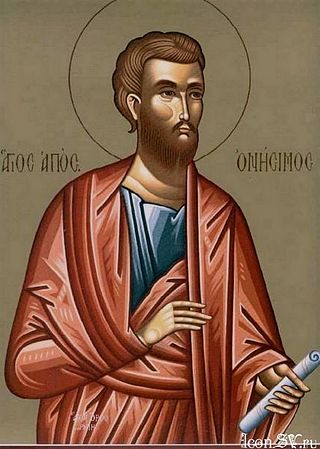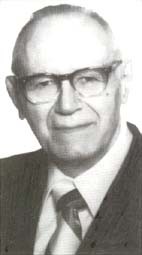Related Research Articles

Colossae was an ancient city of Phrygia in Asia Minor, and one of the most celebrated cities of southern Anatolia. The Epistle to the Colossians, an early Christian text which identifies its author as Paul the Apostle, is addressed to the church in Colossae. A significant city from the 5th century BC onwards, it had dwindled in importance by the time of Paul, but was notable for the existence of its local angel cult. It was part of the Roman and Byzantine province of Phrygia Pacatiana, before being destroyed in 1192/3 and its population relocating to nearby Chonae.

The Epistle to the Ephesians is the tenth book of the New Testament. According to its text, the letter was written by Paul the Apostle, an attribution that Christians traditionally accepted. However, starting in 1792, some scholars have claimed the letter is actually Deutero-Pauline, meaning that it is pseudepigrapha written in Paul's name by a later author strongly influenced by Paul's thought. According to one scholarly source, the letter was probably written "by a loyal disciple to sum up Paul's teaching and to apply it to a new situation fifteen to twenty-five years after the Apostle's death".

The Epistle to the Colossians is the twelfth book of the New Testament. It was written, according to the text, by Paul the Apostle and Timothy, and addressed to the church in Colossae, a small Phrygian city near Laodicea and approximately 100 miles (160 km) from Ephesus in Asia Minor.

The Epistle to Philemon is one of the books of the Christian New Testament. It is a prison letter, authored by Paul the Apostle, to Philemon, a leader in the Colossian church. It deals with the themes of forgiveness and reconciliation. Paul does not identify himself as an apostle with authority, but as "a prisoner of Jesus Christ", calling Timothy "our brother", and addressing Philemon as "fellow labourer" and "brother". Onesimus, a slave that had departed from his master Philemon, was returning with this epistle wherein Paul asked Philemon to receive him as a "brother beloved".

The Epistle to the Laodiceans is a possible writing of Paul the Apostle, the original existence of which is inferred from an instruction in the Epistle to the Colossians that the congregation should send their letter to the believing community in Laodicea, and likewise obtain a copy of the letter "from Laodicea".
And when this letter has been read among you, have it read also in the church of the Laodiceans; and see that you read also the letter from Laodicea.

Mark the Evangelist, also known as John Mark or Saint Mark, was the person who is traditionally ascribed to be the author of the Gospel of Mark. Most modern Bible scholars have concluded that the Gospel of Mark was written by an anonymous author rather than an identifiable historical figure, though the topic remains contentious among experts. According to Church tradition, Mark founded the episcopal see of Alexandria, which was one of the five most important sees of early Christianity. His feast day is celebrated on April 25, and his symbol is the winged lion.

Onesimus, also called Onesimus of Byzantium and The Holy Apostle Onesimus in the Eastern Orthodox Church, was a slave to Philemon, a man of Christian faith. He may also be the same Onesimus named by Ignatius of Antioch as bishop in Ephesus which would put Onesimus's death closer to 107. If so, Onesimus went from slave to brother to bishop.

An epistle is a writing directed or sent to a person or group of people, usually an elegant and formal didactic letter. The epistle genre of letter-writing was common in ancient Egypt as part of the scribal-school writing curriculum. The letters in the New Testament from Apostles to Christians are usually referred to as epistles. Those traditionally attributed to Paul are known as Pauline epistles and the others as catholic epistles.
Marcionism was an early Christian dualistic belief system that originated with the teachings of Marcion of Sinope in Rome around 144 AD. Marcion was an early Christian theologian, evangelist, and an important figure in early Christianity. He was the son of a bishop of Sinope in Pontus. About the middle of the 2nd century (140–155) he traveled to Rome, where he joined the Syrian Gnostic Cerdo.

The Pauline epistles, also known as Epistles of Paul or Letters of Paul, are the thirteen books of the New Testament attributed to Paul the Apostle, although the authorship of some is in dispute. Among these epistles are some of the earliest extant Christian documents. They provide an insight into the beliefs and controversies of early Christianity. As part of the canon of the New Testament, they are foundational texts for both Christian theology and ethics.

Archippus was an early Christian believer mentioned briefly in the New Testament epistles of Philemon and Colossians.

The Pauline epistles are the thirteen books in the New Testament traditionally attributed to Paul the Apostle.

Frederick Fyvie Bruce was a Scottish evangelical scholar, author and educator who was Rylands Professor of Biblical Criticism and Exegesis at the University of Manchester from 1959 until 1978 and one of the most influential evangelical scholars of the second half of the twentieth century. When the academic community looked down upon Evangelicals, Bruce demonstrated that a scholar holding evangelical views could do worthwhile academic work. He persuaded Evangelicals that they should not turn their backs on academic methods of Bible study, even if the results might differ from traditional evangelical views. As a result, he has been called the "Dean of Evangelical Scholarship".
The Laodicean Church was a Christian community established in the ancient city of Laodicea on the Lycus in the Roman province of Asia and was one of the early centers of Christianity. The church was established in the Apostolic Age, the earliest period of Christianity, and is probably best known for being one of the seven churches of Asia addressed by name in the Book of Revelation.

Laodicea on the Lycus was a rich ancient Greek city in Asia Minor, now Turkey, on the river Lycus (Çürüksu). It was located in the Hellenistic regions of Caria and Lydia, which later became the Roman Province of Phrygia Pacatiana. It is now near the modern city of Denizli.
In Christian theology, the gender of the Holy Spirit has been the subject of some debate in recent times.
Mark the cousin of Barnabas is a figure mentioned in the New Testament, usually identified with John Mark.

William Hendriksen was a New Testament scholar and writer of Bible commentaries. He was born in Tiel, Gelderland, but his family moved to Kalamazoo, Michigan in 1911. Hendriksen studied at Calvin College and Calvin Theological Seminary before obtaining an S.T.D. degree from Pikes Peak Bible Seminary, as was typical for on-the-job pastors seeking doctorates in the 1930s and 1940s. It is there that he wrote the thesis More than Conquerors. This book has never gone off the market since it was privately printed and Herman Baker issued it as the first publication of the new Baker Book House in 1940. He received a Th.D. from Princeton Theological Seminary.

The Diocese of Laodicea in Phrygia, is an important titular diocese, centered on the biblical city of Laodicea on the Lycus in modern Turkey. The Church at Laodicea was a centre of Christianity from a very early point. The New Testament indicates a Christian presence in Laodicea as early as the AD 50s. The church is mentioned extensively in the epistle to the Colossians, and the First Epistle to Timothy may have been written here. Further, the church was one of the Seven churches of Asia. A bishop was appointed in Apostolic Times, with numerous suffragan bishop attached.
E. Elizabeth Johnson is an American New Testament scholar and the J. Davison Philips Professor of New Testament at Columbia Theological Seminary. She is widely known for her writings on the New Testament, specifically the Pauline Letters.
References
- 1 2 Sumney, J. L. (2008). Colossians: A Commentary. United Kingdom: Presbyterian Publishing Corporation. pp. 278-279.
- 1 2 3 4 5 6 Dunn, J. D. G. (1994). The epistles to the Colossians and to Philemon. Eerdmans. pp. 283–285.
- ↑ "Letter of Paul to the Colossians | Summary & Facts | Britannica". www.britannica.com. Retrieved 2025-01-31.
- ↑ Talbert, C. H. (2007). Ephesians and Colossians (Paideia: Commentaries on the New Testament). United States: Baker Publishing Group. p. 178.
- 1 2 Balabanski, V. S. (2020). Colossians: An Earth Bible commentary: An eco-stoic reading. Bloomsbury Publishing. https://doi.org/10.5040/9780567693013. Balabanski states "Nympha's name suggests that she had a pagan rather than a Jewish background. In the ancient world, nymphs were female deities living in rural areas (water or forests), and were the ones who crowned Apollo. Her name means 'bride', which has strong symbolic connections within the Johannine tradition with the symbolism of Christ as the bridegroom (e.g. Jn 3.29), though not in Paul's writings. The connection between the name Nympha and water is significant, as monumental fountains were called nymphaea.35 Cities of the region had multiple nymphaea, piping water into the city via clay water pipes or carved travertine stone blocks and distributing it through the city by means of terminals and water towers. Nymphaea were valued!"
- ↑ The Century Dictionary and Cyclopedia: An Encyclopedic Lexicon of the English Language and a Pronouncing and Etymological Dictionary of Names in Geography, Biography, Mythology, History, Art, Etc., Together with Atlas of the World. (1895). United States: Century Company. p. 4047.
- ↑ "The amazing name Nympha: meaning and etymology". Abarim Publications. Retrieved 2025-01-31.
- 1 2 3 4 5 Sumney, J. L. (2008). Colossians: A Commentary. United Kingdom: Presbyterian Publishing Corporation. p. 278.
- 1 2 3 4 5 Wilson, R. M. (2005). Colossians and Philemon. Bloomsbury Academic. p. 305. https://www.google.ca/books/edition/Colossians_and_Philemon/9ZaqEqJcySIC?hl=en&gbpv=1&dq=%22Nympha%22+of+Colossae&pg=PA305&printsec=frontcover
- ↑ Edebe, D. A. E. (2012). Your Women Did Prophesy. United Kingdom: Xlibris US. p. 32.
- ↑ Campbell, D. A. (2014). Framing Paul: An Epistolary Biography. United Kingdom: Wm. B. Eerdmans Publishing Company. p. 278.
- ↑ Meeks, W. A. (2003). The first urban Christians: The social world of the Apostle Paul (2nd ed.). Yale University Press. p. 76. https://fbcclassroom.com/wp-content/uploads/2021/11/The-First-Urban-Christians-The-Social-World-of-the-Apostle-Paul-by-Wayne-A.-Meeks.pdf
- 1 2 Wood, B. (2011). The People Paul Admired: The House Church Leaders of the New Testament. United States: Wipf & Stock Publishers. p. 30.
- ↑ Thomaskutty, J. (2022). An Asian introduction to the New Testament. Augsburg Fortress Publishers. p. 317.
- ↑ Thurston, B. B. (2004). Women in the New Testament: Questions and Commentary. United States: Wipf & Stock Publishers. p. 133.
- ↑ Balabanski, V. S. (2020). Colossians: An Earth Bible commentary: An eco-stoic reading. Bloomsbury Publishing. https://doi.org/10.5040/9780567693013. Balabanski states "Nympha and her household may have been involved in textile production. The wealth of this region came from textile products, manufactured from the wool of the sheep raised in the area, which included raven-coloured, brown and grey as well as white sheep. The yarns were dyed various shades of red and purple, with dye obtained from the roots of a plant named Rubai tinctoria L. (madder), grown around the city."